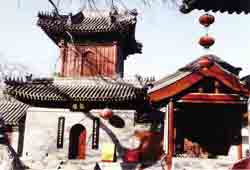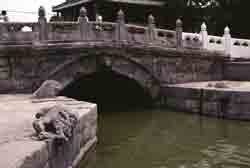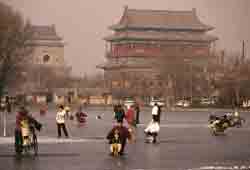| 古老什刹海的百年发展和变迁(图) | |
| http://www.sina.com.cn 2004/07/19 14:04 中国周刊 | |
Shichahai - Historical district becomes a top spot in modern Beijing By BRUCE CONNOLLY It seems ironic that Beijing has a water shortage for it is water that enhances the city's beauty. Although on the edge of a dry zone China's capital is actually home to many fine waterways and a network of man-made lakes virtually in the city centre. When the Imperial City was being built the surrounding area was not only short of water but also lacking variety in fresh vegetables and rice. Meanwhile the area around the Yangtze Delta was a region of abundance. Early engineers devised a series of canals to bring produce northwards. To facilitate access right into the heart of the city and to provide a reliable water supply for the Palace, several large lakes were dug in a line stretching northwest towards Xizhimen. The top group of lakes, collectively known as Shichahai, comprises Xihai (West Lake), Houhai (Back Lake) and Qianhai (Front Lake). They are connected to present day Beihai (North Lake) Park dominated by its great White Dagoba. This lake then flows into those adjacent to the Palace - Zhongnanhai (Middle South Lake) and Nanhai (South Lake). Early commercial activity
The Shichahai lakes fulfilled commercial purposes compared to those to the south which were reserved for the private pleasures of the imperial family. The shores around Shichahai were lined with small docks. By the canals joining the three lakes considerable activity took place - unloading cargoes onto carts, hundreds of men with loads suspended from poles struggling under their weight, small shops serving the needs of the boatmen, food stalls preparing simple everyday meals, and so on. This was particularly the case around the narrow constriction still crossed by the artistically fine Silver Ingot Bridge. Although home to the ordinary people, there were considerable contrasts in the area. Dominating the scene are the fine towers of Gulou and Zhonglou - the Drum and Bell Towers of Old Beijing. Every day their tolls indicated it was time for the city's gates to close and early every morning they reminded civil servants that they had to be in their positions at the Imperial Palace before the emperor appeared. Many of these officials lived in the 'siheyuan' or courtyard houses crowding into this area. Their smaller houses, painted in the grey colour of the ordinary people rubbed shoulder with the grand homes and palaces of princes. They, attracted by the area's natural beauty and charms, chose to reside there rather than within the confinement of the main palace. In much smaller dwellings stayed the shopkeepers, canal workers, porters and everyone else who kept this area functioning. Today this is the city's best-preserved hutong district. Period of decline Decline ultimately set in due to the rise of rail transport. Canal boats were slow. With the coming of the railways in the late 19th and early 20th century, much of the northern traffic on the Grand Canal ended and indeed some sections of the canal actually dried up. Beijing's lakes became neglected backwaters as economic activity transferred to other parts of the city. For a long time the area literally slept. Life continued behind the walls of the hutong alleys almost in a time immemorial scenario although the surrounding city was developing. The palaces and mansions underwent changes for the imperial family were gone. Indeed one on the eastern side of Houhai became the residence from 1963 to 1981 of SongQingling, the wife of Dr Sun Yat-sen, father of Modern China.
Underneath the willow trees overhanging the lakes, thus shaded from the summer sun, men continued to fish while groups of their friends noisily competed over games of mahjong, chess(majiang) or cards. Others swam in the waters in summer or through holes in the ice in winter - activities still underway today. Meanwhile bamboo birdcages were hung from trees while locals silently glided past on bicycles. This was a world in a 'time-warp' far removed from the tourist scene developing at the same time elsewhere in the city, combined with the growth of modern residential areas beyond Erhuan (No 2 Ring Road). Changes started to happen This area, visited only by a curious few, began to change in the late 1990's. As the People's Republic approached its 50th anniversary many environmental improvement projects were initiated. The lakes were enhanced by a thorough removal of accumulated silt. Railings around the banks were replaced; tiled pavements were laid and surrounding areas of vegetation landscaped. Coupled with a general improvement in air quality throughout the city the district appeared much improved. The area started to be 'rediscovered'. Citizens increasingly had more leisure time. Shichahai with its clean atmosphere and a feeling of space away from the confines of late 20th century urban life was ideal for recreation - everything from simply walking around the lakes to boating and kite flying. Artists captured its beauty and interest on canvas and the increasing number of foreigners coming to the city became aware of its attractions. It offered the chance to 'escape' without having to travel out to the countryside. It also provided the chance to experience traditional old Beijing life. Commercial potential realised Inevitably, its commercial potential started to be realised. Initially, tourists were transported around its attractive lanes by pedicabs, stopping to visit courtyard homes and experience traditional teahouses. This was extended to cruises on the lakes. Visitors slowly travelled across the waters on wooden craft powered by a oarsman standing at the rear. A girl sitting at the front entertained with melodies played on traditional instruments. Meanwhile visitors enjoyed dinner afloat - a delightful summer evening experience. Around the shores young couples, captivated by the area's romantic atmosphere, walked or sat together.
The next stage came with the opening of bars. A couple of teahouses and cafe-bars appeared along the southwest side. They were hideaways where people would sit for hours talking over a coffee, reading or leisurely watching life pass by on and off the water. Near the Silver Ingot Bridge two fashionable restaurants had long-established reputations. Around them traditional life seemed unstoppable - until the bars began to open. First came No Name, internally resembling an antique shop and offering great views over Qianhai. Behind it the Nuage Vietnamese restaurant was a welcome addition. Soon several small one-room bars, such as the Buddha with its many photos of local scenes, opened just across the bridge and quickly became popular. Their reputation spread amongst both the foreign and domestic communities. Very quickly this area around the lakes began to change. Like tentacles, lines of bar started to spread out from the bridge along the sides of the lakes. Adjoining alleys such as the Lane of the Long Stem Pipe Makers also attracted bars that led to a significant change in the character and appearance of the area. To compete for customers each establishment tried to offer better interior design than their neighbours. Considerable use of natural wood helped to maintain a traditional feeling, as did the use of replica traditional furniture. Many places provided rooftop sitting areas offering super views of the surrounding hutongs and alleys. The growth of the bars seemed almost unstoppable with some opening at the top end of Houhai and in secluded spots around much quieter Xihai. A new bar street, Lotus Lane, also opened recently along the southwest shore of Qianhai in what was formerly a quiet antique alley. Concerns grew Concern was expressed about this mushrooming development. A few bars built additions to their buildings that bore little relationship to local styles. Some played loud music and there was worry about the number of people descending on the area at weekends. There was understandable anxiety that the unique character of the area was being destroyed. The local authority eventually took measures to control the situation and structures out of tune with the area were pulled down. Traffic controlling rules were also introduced.
In 2003 a voluntary organisation of bar owners was established to keep a Shichahai theme dominant among the bars and to hopefully prevent any development that might physically threaten the very reason why this area became popular in the first place. Many bars have realised, for example, that noisy Western music will actually discourage some customers, including the very foreigners they hope to attract. This area is unique It is important to emphasise that this area is not another Sanlitun or Chaoyang Park - in those districts buildings are often new structures, whereas in Shichahai apart from the Lotus Lane area most bars are converted from former houses that tended to follow local traditional patterns. Generally also most bars are quieter, both in numbers of customers and noise. Many visitors going there want places to relax, talk and be absorbed with the daily goings on of local life. Indeed it can be very pleasant in summer sitting at outdoor tables with an enchanting view over the waters. Some bars did open too quickly without a real idea of the potential market and closures have occurred. Some however are still under construction and a lot of costly work is going in to the building work. Indeed the Lotus Lane features expensive purpose-built properties quite different to those around Silver Ingot Bridge. There is a feeling that after the initial rush of development the situation is settling down. Much more than bars
Despite its present reputation there is still much more to the area than bars. All lanes leading away from the lakes allow the opportunity to delve into local hutong life, seemingly a world away from that along parts of the shore. In reality the bars do not stretch right round the lakes, either. Some sit alone in quiet, unspoilt spots. A walk around the district can be enjoyable at any time of the year as locals still fish and exercise. Many people still live there although some buildings have been replaced by fashionable modern town houses built in courtyard style complete with double-garages. Smart offices resembling domestic dwellings have also appeared. Environmental improvements continue A lot of recent environmental work has improved conditions for local inhabitants - new exercise areas are ideally placed adjacent to the shores. Small parks have been smartened up and restocked with new plants. Lighting in key areas such as the Silver Ingot Bridge and around some prominent buildings add charm in the evening. Restoration work has included rebuilding two years ago the Wanning Bridge spanning a canal formerly flowing out from Qianhai. Also there, a temple previously hidden behind a mess of old buildings has been restored to view. Another temple, the Yuan dynasty (1279-1368) Guanghua, in a quiet lane close to Houhai continues to add peace and tranquillity to the area. Indeed, standing on the Silver Ingot Bridge while wooden dining boats pass underneath and the sun is setting behind the Fragrant Hills, there is a sense of magic. There is also a feeling of history both in the local buildings and the fact that these great reservoirs of water enhancing the city's beauty were actually dug out by man during the Yuan dynasty. If that great feat of engineering had not taken place Beijing would indeed be a very different city. Thankfully that work was undertaken and has given us the living recreational area that is present day Shichahai.
| |
| 【英语学习论坛】【评论】【大 中 小】【打印】【关闭】 |




